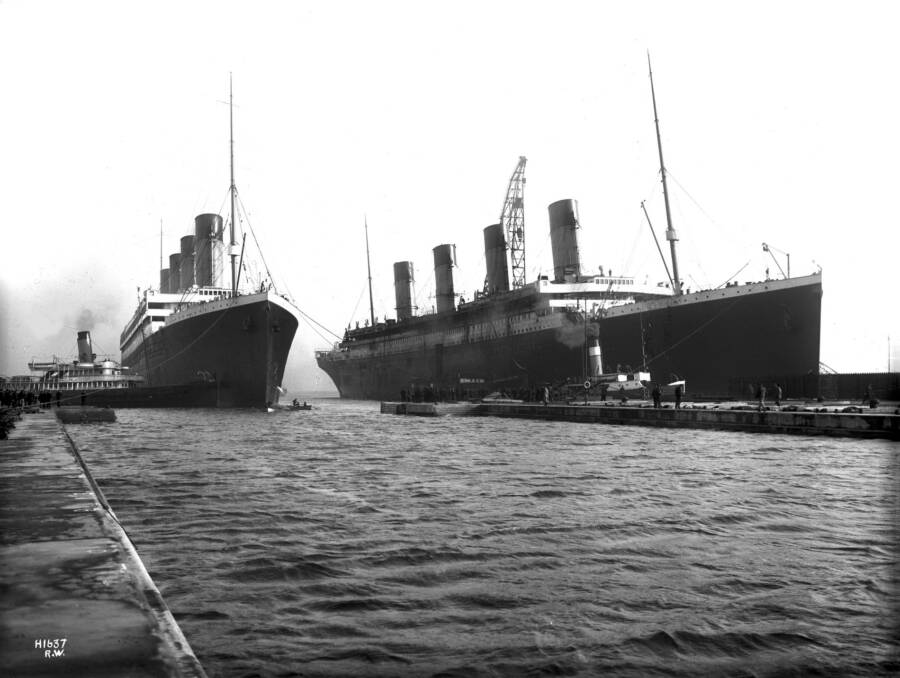From a millionaire's murderous plot to a mummy's curse, discover some of the wildest theories about the Titanic and its ill-fated voyage.
In the early hours of April 15, 1912, distress calls went out from the RMS Titanic in the North Atlantic Ocean. The Titanic was just four days into its maiden voyage from England to New York City when the ship suddenly hit an iceberg about 400 miles off the coast of Newfoundland.
The largest passenger liner of its time, the Titanic was once thought to be “unsinkable.” But just under three hours after the ship struck the iceberg, the ship had completely sunk, taking about 1,500 people down with it.
Afterward, conspiracies about why and how the Titanic sank abounded, ranging from the simple and plausible to the extreme and outlandish.
Here are seven of the most popular conspiracy theories about the Titanic.
The Conspiracy Theory That The Titanic Never Actually Sank At All

Public Domain/Wikimedia CommonsThe RMS Olympic (left) and the RMS Titanic (right) shared so many similarities to the untrained eye that some have theorized that the ship that sank was actually the Olympic.
One of the most elaborate Titanic theories is that it wasn’t actually the Titanic that sank — it was the Titanic’s sister ship, the RMS Olympic. This theory has been around for decades, but it was popularized by Robin Gardiner’s 1998 book Titanic: The Ship that Never Sank?
The Titanic and the Olympic were both part of a trio of ships that had been commissioned for the White Star Line shipping company in the early 1910s. (The third ship in the trio was the RMS Britannic.)
In September 1911, the Olympic collided with another ship off the southern coast of the U.K., just months after it was completed. It had two large holes in the hull and damage to the propellor, requiring months of repairs — time and money that was supposed to go into preparing the Titanic.
So the conspiracy theory claims that to recover the money lost from the Olympic, the company simply sent the Olympic out instead of the Titanic. When the “Titanic” sank just days into its maiden voyage, the company would collect a large sum of insurance money on the “brand-new” ship.
Believers in this Titanic conspiracy theory point to physical and circumstantial evidence to make their case.
First, they say that while the Titanic and Olympic were very similar, there were small differences between them, such as their number of portholes. The Olympic had 16 portholes and the Titanic had 14. But photos of the Titanic’s maiden voyage appear to show a ship with 16 portholes.
Additionally, a number of high-profile passengers, including millionaire banker J.P. Morgan (who owned the ship), backed out of the voyage at the last minute. Believers claim this is because they knew the ship was doomed.
And one of the oddest unexplained occurrences at the time of the Titanic’s sinking was the behavior of the SS Californian. The Californian, which was also owned by J.P. Morgan, came under intense scrutiny after the Titanic sank, as it was the closest ship at the time of the crash and saw the doomed liner’s distress signals — but did not take any action to help.
The conspiracy theory claims that the Californian was intended to be the rescue ship for the Titanic’s planned crash, since it was carrying 3,000 wool blankets and sweaters, but no passengers. The ship’s inaction is believed by some to be the result of a miscalculation of the Titanic’s location.
However, the Olympic exchange theory has been debunked by experts, according to Reuters. Much of the “evidence” the theory points to is either incorrect or has an alternate explanation, especially the physical evidence.
For example, records show the Titanic did have 14 portholes at first, but two more were added before it left on its maiden voyage (the Olympic also originally had 14 portholes before two were added). And the Titanic was only insured at two-thirds of its cost, meaning if it sank, the White Star Line would still lose money, making the whole “insurance scam” a moot point.





